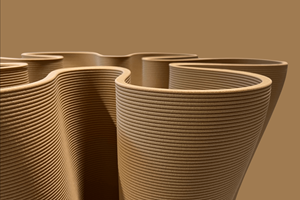Aerospace and industrial composites: Now on divergent paths?
The aerospace and industrial markets’ advanced composites challenges and their solutions will differ widely.
Late in 2014, I wrote several columns that pointed to a convergence between the aerospace and industrial markets for advanced composites. Several signs pointed to this. SAMPE and ACMA came together that October to form a single CAMX trade show and conference, covering all composites applications. Composites Technology and High-Performance Composites became this single magazine, called ÂÌñÏ×ÆÞ. In the final issue of Composites Technology (December 2014), I opined, “We’re moving toward a time when aerospace and automotive technical advances will be interchangeable and extend well beyond the use of carbon fiber.” Additional columns in the months following built on this theory of convergence, noting the contributions of aerospace, like software tools for composites and nondestructive evaluation to the advances of composites in industrial applications, and the efforts in high-speed fabrication in automotive finding eventual use in aerospace.
The convergence model can be illustrated by two highways coming together to form a super-highway to a common destination. After decades of crossing widely disparate materials, processes and designs — both markets now chase similar objectives for multi-material solutions, lower costs and higher volumes.
But what if this isn’t a merging of traffic, but merely an intersection? Or, to continue the highway metaphor, a “roundabout,” where two streams of traffic enter, but the majority continues out via separate roads to different destinations? What if the past two years have simply been a transient moment in time and technology where there was a lot of common territory?
The event that triggered these thoughts was the ÂÌñÏ×ÆÞ Carbon Fiber conference in November. The first day was very aerospace-focused. Day two focused on automotive and low-cost, alternative precursors for carbon fiber. As I listened to presentations, it struck me that each market faces very different challenges. And that solutions will differ widely as well.
Start with carbon fiber. The major suppliers of aerospace-qualified carbon fiber could cut the price in half, and it would have a negligible effect on the size of the aerospace carbon fiber market. It is just not that sensitive to material pricing, which represents less than 20% of part costs. On the other hand, if the price of industrial-grade carbon fiber were suddenly reduced by 50%, it would open big opportunities in automotive and wind energy markets. One could argue that this is a prerequisite to achieve significant penetration and helps explain the strong interest in alternative precursors such as textile PAN, bio-based PAN and pitch.
Significant levels of automation are being developed for both aerospace and automotive. A lot of effort is going into machines to make simple, repetitive carbon fiber elements for aircraft — beams, stringers and frames, for example. This is in addition to multi-million-dollar fiber placement machines already prevalent in wing and fuselage layup, where the molds remain stationary and only the gantry and heads move. The layup machines under development for automotive are focused on small- to medium-sized parts, principally laying up 2D patterns, using wider tapes, with shaping happening during the molding process. These machines have relatively small footprints, move the table as much as the head, and are a fraction of the cost of the aerospace machinery.
Finally, the markets’ volume levers are distinctly divergent. Chris Red of Composites Forecasts and Consulting LLC (Mesa, AZ, US) estimates that commercial aircraft structures consumed 7,500 MT of carbon fiber in 2016, and this will grow to slightly more than 10,100 MT in 2025, an increase of about 35%. This represents maturation of widebody aircraft programs and organic market growth. Should Boeing and Airbus elect to put carbon fiber wings on every narrowbody aircraft built (admittedly, a very optimistic scenario) this would add 7,000 MT to this forecast, at 5 MT per aircraft, assuming growth to 1,400 aircraft per year. For OEM automotive, Red’s numbers go from just under 12,000 MT to almost 33,000 MT in the same period, nearly tripling the market. And his numbers might be low. Andreas Wuellner of SGL Carbon Fibers (Wiesbaden, Germany) envisions 20% of the world’s 100 million vehicles built in 2025 using 2 kg each — an annual market of 40,000 MT. This isn’t exactly a stretch, either. It could easily be double or even quadruple this figure with just a few technology breakthroughs.
As both markets drive through the roundabout into the future, we could be looking at very distinct industries, with different casts of suppliers, manufacturers and technologies. And surprisingly little crossover.
Related Content
Plant tour: Airbus, Illescas, Spain
Airbus’ Illescas facility, featuring highly automated composites processes for the A350 lower wing cover and one-piece Section 19 fuselage barrels, works toward production ramp-ups and next-generation aircraft.
Read MorePlant tour: Collins Aerospace, Riverside, Calif., U.S. and Almere, Netherlands
Composite Tier 1’s long history, acquisition of stamped parts pioneer Dutch Thermoplastic Components, advances roadmap for growth in thermoplastic composite parts.
Read MoreSulapac introduces Sulapac Flow 1.7 to replace PLA, ABS and PP in FDM, FGF
Available as filament and granules for extrusion, new wood composite matches properties yet is compostable, eliminates microplastics and reduces carbon footprint.
Read MorePlant tour: Teijin Carbon America Inc., Greenwood, S.C., U.S.
In 2018, Teijin broke ground on a facility that is reportedly the largest capacity carbon fiber line currently in existence. The line has been fully functional for nearly two years and has plenty of room for expansion.
Read MoreRead Next
Next-gen fan blades: Hybrid twin RTM, printed sensors, laser shock disassembly
MORPHO project demonstrates blade with 20% faster RTM cure cycle, uses AI-based monitoring for improved maintenance/life cycle management and proves laser shock disassembly for recycling.
Read MoreUltrasonic welding for in-space manufacturing of CFRTP
Agile Ultrasonics and NASA trial robotic-compatible carbon fiber-reinforced thermoplastic ultrasonic welding technology for space structures.
Read MoreScaling up, optimizing the flax fiber composite camper
Greenlander’s Sherpa RV cab, which is largely constructed from flax fiber/bio-epoxy sandwich panels, nears commercial production readiness and next-generation scale-up.
Read More











